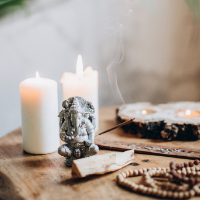A Beginner's Guide to Meditation
| Skup Collaborator

Meditation is simple, but not easy
Meditation is a simple way of freeing your mind from daily anxieties to help bring forward feelings of peace and resiliency. It's about being a passive observer of your thoughts, not engaged with them.
The concept is simple in theory, yet harder in practice. Our minds like to think—it's what they do best!
With life obligations pulling us in multiple directions, it can be hard to incorporate a new habit, so as you start a new meditation practice, start small—3 to 5 minutes each day. Don’t set lofty expectations to meditate for an hour because you’ll only set yourself up for disappointment and discouragement.
After being consistent with 3-5 minutes for 5-7 days of the week, increase your time in small increments and, over time, you’ll find a length of time that feels beneficial and works with your lifestyle.
Remember, meditation has no rules or judgement—you can meditate for just 60 seconds a day, if you wish!
In this fast-moving world, we can all benefit from incorporating meditation on some level into our daily lives. Every bit of meditation helps to bring us closer to feeling a sense of calmness and peace.
Let's get started
Meditation is not about the elimination of thoughts. It's the art of focusing the mind on a particular object or thought in order to train attention and awareness, and achieve a mentally clear and emotionally calm state. It's returning to a particular focus—over and over again—which is why we call it a practice.
Choose your focus.
Your focus could be a mantra (phrase), your heart space, a meaningful word, candle flame, or beaded bracelet. Whatever you choose, it's where you'll direct (and re-direct) your focus during your meditation sessions.
How to deal with a roving mind during meditation
Whether you’re a first-time or seasoned meditator, chances are high that you’ll be subject to a stream of thoughts. This is normal. Don’t let it discourage you!
Remember, thinking is what the mind does best.
When you have thoughts wander into your mind:
-
Recognize that you have a thought, but do not judge the thought
-
Gently return to your chosen focus
-
Repeat steps 1 & 2 as needed (it might be repeated a lot!)
The best time of day to meditate
Some people meditate when they first wake up. Others have a routine of meditating mid-day. Still others meditate before bed. The important thing is to find a time that works for you—as opposed to following ideas about when you think you “should” be meditating.
Experiment with different times to figure out what time of day is best for you. Most importantly, consistency is key. So no matter what time of day you meditate, practice daily, even for just a few minutes at a time.
Make an appointment with meditation and show up…you’ll be glad you did.
The best place to sit during meditation
The beauty of meditation is that you can do it anywhere. However, for your daily practice, it’s suggested to choose an area to be your dedicated meditation spot. Pick a place where you will be least likely to be disturbed.
Meditating in the same spot every day helps you become conditioned to your meditation setting. Some people find it helps to decorate their meditation area with flowers, candles, lamps, a meaningful picture, etc. But, of course, you don’t need any props or decorations to meditate.
Open or closed eyes
Most people find it easiest to meditate without external distractions, and will close their eyes when practicing. However, some people are uncomfortable meditating with their eyes closed and will do an open-eyed meditation—softly gazing down at the floor—which is also okay.
Do whatever makes you feel most comfortable.
To sit or lie down
Generally, people practice meditation in a sitting posture, but your position of choice is entirely up to you. If sitting on the floor feels natural, enjoyable, and supportive and your body is fairly pain-free in this posture, please meditate on the floor.
Some people like to use a small rounded cushion for support when practicing meditation on the floor. Otherwise, feel free to sit in a chair. Some people even prefer to lie down and that’s okay, too, just make sure you’re not so relaxed that you fall asleep during your meditation practice…a nap doesn’t count as meditation!
Above all, be kind to yourself
Meditation includes self-compassion. Give yourself a lot of leeway to explore what forms of meditation and for what amount of time works within your lifestyle. Don’t set the bar too high with high expectations for yourself that could to lead to frustration.
Approach mediation with an exploration attitude—experiment and find what works for you. It may take several weeks or even months before you begin to establish a routine with which you feel comfortable. Keep at it.
Over time, there’s a good chance that your daily practice will enhance your well-being, provide joy, and promote self-reflection—as well as act as your foundation for cultivating a sense of calm and mindfulness in every aspect of your life.
This content is for informational purposes only and is not intended to be a substitute for professional medical advice, diagnosis, or treatment. Always seek the advice of your health provider with questions you may have about a medical condition.
A Beginner's Guide to Meditation
People's Herbs - Ancient Beauty in a Modern World
www.PeoplesHerbs.com
